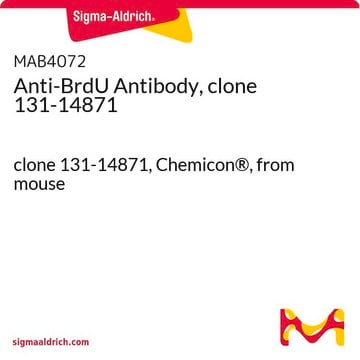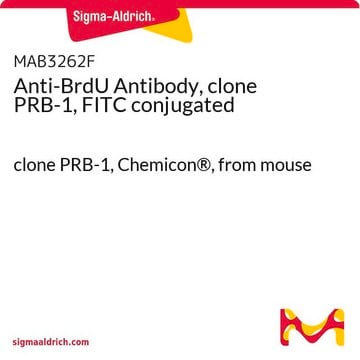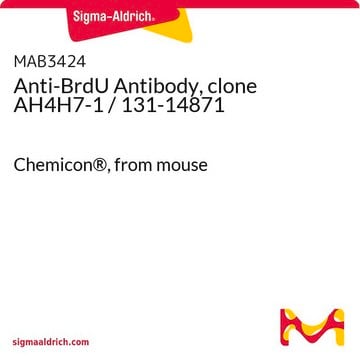B8434
Anti-BrdU antibody, Mouse monoclonal
clone BU-33, purified from hybridoma cell culture
Synonim(y):
Monoclonal Anti-BrdU antibody produced in mouse, Anti Brdu, Brdu Antibody, Brdu Antibody - Anti-BrdU antibody, Mouse monoclonal, Anti-Bromodeoxyuridine
About This Item
Polecane produkty
pochodzenie biologiczne
mouse
Poziom jakości
białko sprzężone
unconjugated
forma przeciwciała
purified from hybridoma cell culture
purified immunoglobulin
rodzaj przeciwciała
primary antibodies
klon
BU-33, monoclonal
Postać
buffered aqueous solution
reaktywność gatunkowa
wide range
opakowanie
antibody small pack of 25 μL
stężenie
~1.5 mg/mL
metody
immunocytochemistry: suitable
immunohistochemistry (formalin-fixed, paraffin-embedded sections): 1-2 μg/mL using sections of intestine from mice or rats treated in vivo with BrdU
izotyp
IgG1
Warunki transportu
dry ice
temp. przechowywania
−20°C
docelowa modyfikacja potranslacyjna
unmodified
Szukasz podobnych produktów? Odwiedź Przewodnik dotyczący porównywania produktów
Opis ogólny
Anti-BrdU antibody, Mouse monoclonal (mouse IgG1) is derived from the BU-33 hybridoma produced by the fusion of murine myeloma cells and splenocytes from BALB/c mouse immunized with bromodeoxyuridine (BrdU) conjugated to KLH.5′-Bromo-2-deoxyuridine (BrdU) staining is predominantly used to observe the multiplication of tumor cells and other tissues in vivo.
Specyficzność
Immunogen
Zastosowanie
- BrdU labeling
- immunohistochemistry
- immunostaining
- BrdU assay
- to detect 5-fluorouridine-labelled RNA
- to detect 5-bromo-2′-deoxyuridine (BrdU) labelled immunoreactive cells
- against BrdU labelled rat retinal sections
Postać fizyczna
Przechowywanie i stabilność
Oświadczenie o zrzeczeniu się odpowiedzialności
Not finding the right product?
Try our Narzędzie selektora produktów.
Kod klasy składowania
12 - Non Combustible Liquids
Klasa zagrożenia wodnego (WGK)
WGK 1
Temperatura zapłonu (°F)
Not applicable
Temperatura zapłonu (°C)
Not applicable
Certyfikaty analizy (CoA)
Poszukaj Certyfikaty analizy (CoA), wpisując numer partii/serii produktów. Numery serii i partii można znaleźć na etykiecie produktu po słowach „seria” lub „partia”.
Masz już ten produkt?
Dokumenty związane z niedawno zakupionymi produktami zostały zamieszczone w Bibliotece dokumentów.
Klienci oglądali również te produkty
Nasz zespół naukowców ma doświadczenie we wszystkich obszarach badań, w tym w naukach przyrodniczych, materiałoznawstwie, syntezie chemicznej, chromatografii, analityce i wielu innych dziedzinach.
Skontaktuj się z zespołem ds. pomocy technicznej










